Premise
An empathetic chatbot can help individuals feel supported and understood while searching for information in a stressful situation. Buddy the Bot is created to help individuals facing energy poverty find useful information for reducing energy bills and avoiding electricity disconnection.
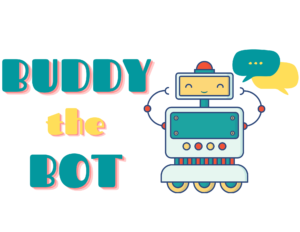
Synopsis
Around 1 million households in the Netherlands are suffering from energy poverty (Sia Partners, 2017); the inability to afford proper indoor thermal comfort, cooking, appliances, and/ or information technology (European Union, n.d.). Shame associated with energy poverty (Royston, Royston, & Guertler, 2014), often prevents individuals from seeking help (Longhurst & Hargreaves, 2019) but a chatbot offers a level of anonymity that enables individuals to open up about embarrassing situations (Antony et al., 2021). This research explores how an empathetic, artificially intelligent chatbot can assist energy poor households in reducing their energy bills to mitigate the harmful impacts of energy poverty. By training the chatbot to behave empathetically, users will feel supported during the stressful situation of searching for solutions to avoid electricity disconnection. While it is important that the chatbot provide accurate, relevant, and easy-to-understand advice; it is also important that users feel listened to and understood. By training Buddy the Bot to understand users’ tone then respond according to the emotion identified in the message, users will feel that their issues are taken seriously, their feelings are considered and that the situation overall is handled with great care.
Substantiation
The initial goal of the technological research was to develop a smartphone app that connects to smart meters and provides low-income households with detailed, household-specific recommendations for energy use reduction. However; after diving deeper into the struggles faced by those living in energy poverty, it became clear that a more easily accessible solution would be required.
Resources for exploration into the effects of energy poverty on the individual:
How AI can alleviate energy poverty
Energy Poverty | Stories from Spain
Energy Poverty | Stories from Portugal
Living in Energy Poverty Documentary
ENERGY POVERTY in the European Union
The following image depicts a summary of the effects of energy poverty as observed in the above resources:

The next step is to discern how the chatbot can help energy poor individuals and what sort of resources are already available.
Technical Overview
Through exploration of the tools available, it became clear that a new, easy-to-use solution specifically catered to energy poor individuals is needed. Since chatbots are presented in a format users are already familiar with, they are highly accessible (Lee et al. 2019), and therefore present a better solution than an app integrated with in-home smart meters (as many energy poor households do not have smart meters yet). This led to the development of Prototype 1 (to launch the bot please type ‘tips for reducing energy bill’ or something similar).
User Testing
The target audience for this prototype are energy poor students in the Netherlands. The students do not necessarily have to be Dutch citizens (although this is possible) but they do have to be currently (legally) residing in the Netherlands and experiencing difficulties affording their energy bill. In order to help the largest number of students as possible, the chatbot is developed in English. Developing the chatbot in Dutch would exclude international students, and since many university programs in the Netherlands are in English, this is the best option. The first round of user testing was conducted with 4 international students currently studying in the Netherlands. After user testing prototype 1, it became clear that the bot was not resonating with users and it felt very mechanic. The users felt they were not receiving personalized answers and it was essentially a very limited search platform. This is where AI, sentiment/ tone analysis and empathetic chatbots make an appearance.
Tone Analysis
Substantiation
Humans respond socially to technology, and reactions to computers (or chatbots) can be similar to reactions to other humans (Reeves & Nass, 1996). The similarity-attraction hypothesis predicts that people with similar personality characteristics will be attracted to each other (Nas & Lee, 2001). This finding also pertains to user acceptance of technology (Nass & Lee, 2001; Nass et al., 1995), essentially the emotional factors that influence human-to-human relationships will also influence human-to-chatbot relationships (Lee & See, 2004). Chatbots that understand human emotion and display personality characteristics similar to the user, are often accepted and liked by the user.
Technical overview
Based on the insights gained from tone analysis research and instructions from the DataCamp tutorial and this YouTube tutorial, Watson Tone Analyzer is used to identify the users tone in multiple messages. I used these skills to explore how the tone analyzer works and how it reads sentences regarding energy poverty and requests for bill paying assistance.

This sentiment analysis of messages specifically pertaining to topics surrounding energy poverty is very important because the situation needs to be handled with tact and care. Keeping the insights from the human exploration of energy poverty in mind, individuals living in energy poverty are often embarrassed to ask for help (Royston, Royston, & Guertler, 2014), and the situation overall is very stressful. These are contextual insights that Tone analyzer cannot consider, so it is important to sort through the tones and identify appropriate responses for each scenario. The sentiment analysis process and detailed notes can be found here: Tone Analysis Exploration
User Testing
User testing was conducted with 11 users to identify potential inputs and the appropriateness of the empathetic responses. When asked to imagine a situation where the bot is not understanding the users input, 8 out of 11 users indicated that they would ask to speak to a human agent. Making sure that the bot understands the users request on the first try is vital to the overall user experience and therefore, to the success of the prototype.
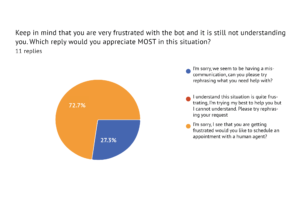
The goal is to make the user experience of Buddy the Bot very pleasant and human-like, so if users are requesting to speak to a human agent, the chatbot is not successful. The images below show how diverse the input cases can be across users.

The insights from this round of user testing led to the addition of many new input cases, this improves the chance that the bot will understand the users. Therefore, reducing the likeliness that a user will feel the need to request a human agent. However, this also presents a need for many rounds of additional user testing as well as the addition of multiple-choice options in the conversation to ensure a greater success rate of bot understanding. View the tone analysis of input cases defined in user testing in this Github Notebook.
Overview of Prototype
In order to have an artificially intelligent, empathetic chatbot, Watson Assistant must be used instead of PowerBI VA, so the next prototype is built here. This chatbot can be found here: Buddy the bot. In order to make Buddy the bot behave more naturally, pauses and typing indicators are included; this increases perceived humanness of the bot (Gnewuch et al., 2018).
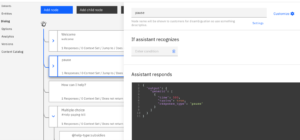
User testing also revealed that multiple choice questions and personalized results expressed as action items are the most efficient ways to help users. Multiple choice items with links that allow users to immediately sign up for help in their respective cities are also added.
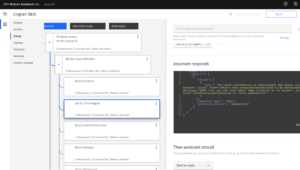
The next step is to integrate tone analyzer into Prototype 2.
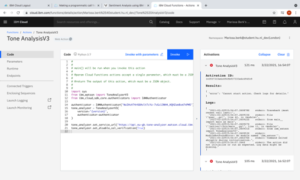
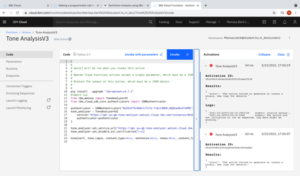
The screenshots above show some attempts to integrate tone analysis into the chatbot based on this tutorial provided by IBM. Unfortunately the linked pages (below) for the content I need, regarding how to link the tone analyzer to Watson assistant, are no longer available.
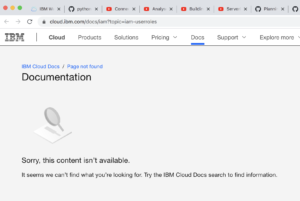
The most recent YouTube tutorials provided by IBM are from 2017 and are regarding IBM’s old chatbot interface- conversations: Watson Assistant using Cloud Functions, Connecting tone analyzer to conversations. I opened a support request to IBM regarding the broken links and lack of information on the topic and am waiting for a response.
In the meantime, deeper exploration into tone analysis and more user testing will continue in order to develop appropriate chatbot responses.
Conclusion
Although there were many obstacles along the way, these challenges provided the opportunity to rethink the situation and slow down and test each assumption. The next steps include, implementing Tone Analyzer into Buddy the Bot, conducting more user testing to identify additional ways to assist the users as well as a deeper exploration into Watson Assistant and the additional features that can make the prototype appear as human as possible. Additionally, an expert in the field of energy poverty has been contacted and an interview is scheduled for April 12th. Furthermore, this technological exploration illuminated the importance of the data-driven loop. The goal is to create a user experience (with technology) that is so seamless that users do not feel the need to request a human agent. By constantly training the chatbot as each user interacts with it, Buddy the Bot can be improved upon to become more human-like and more efficient with each interaction.
References
Antony, C., Pariyath, B., Safar, S., Sahil, A., & R Nair, A. (2021). Emotion Recognition-Based Mental Healthcare Chat-bots: A Survey. International Conference on IoT based Control Networks and Intelligent Systems (ICICNIS 2020).
ENERGY POVERTY in the European Union, YouTube, 12 Apr. 2016, www.youtube.com/watch?v=0tZ9-9hmSOw.
EU Energy Poverty Observatory. (2018). SMART-UP: Consumer Empowerment in a Smart Meter World.
EU Energy Poverty Observatory. (2020). Member State Report Netherlands. Luxembourg: Publicstions Office of the European Union.
European Union. (n.d.). Energy Poverty. Retrieved from European Commission: https://ec.europa.eu/energy/eu-buildings-factsheets-topics-tree/energy-poverty_en
Gagan, O. (2021). How AI can alleviate energy poverty. Raconteur: Artificial Intelligence.
Gnewuch, U., Morana, S., Adam, M., & Maedche, A. (2018). Faster is Not Always Better: Understanding the Effect of Dynamic Response Delays in Human-Chatbot Interaction. Association for Information Systems, 1-17.
Lee, J., & See, K. (2004). Trust in Automation: Designing for Appropriate Reliance. Human Factors, 46, 50-80.
Living in Energy Poverty Documentary, YouTube, 18 Jan. 2019, www.youtube.com/watch?v=WZRL-jeC_qc.
Longhurst, N., & Hargreaves, T. (2019). Emotions and fuel poverty: The lived experience of social housing tenants in the United Kingdom. Energy Research & Social Science, 101-207.
Nas, C., & Lee, K. (2001). Does computer-synthesized speech manifest personality? Experimental tests of recognition, similarity-attraction, and consistency-attraction. Experimental Psychology – Applied, 7, 171-181.
Reeves, B., & Nass, C. (1996). The media equation: How people treat computers, television, and new media like real people and places. New York: Cambridge University Press.
Royston, S., Royston, S., & Guertler, P. (2014). Reaching Fuel Poor Families: Informing new approaches to promoting take-up of fuel poverty assistance among families with children. Report to the Eaga Charitable Trust, Association for the Conservation of Energy and The Children’s Society.
Sia Partners. (2017). 1 million Dutch households affected by energy poverty. SIA Partners News & Publications.
SocsandDems, director. Energy Poverty | Stories from Portugal, YouTube, 22 Mar. 2017, www.youtube.com/watch?v=C2_ZVG-qnfY.
SocsandDems, director. Energy Poverty | Stories from Spain, YouTube, 17 Feb. 2017, www.youtube.com/watch?v=4PUy1X3f-X8.
Thegatesnotes, director. Energy Poverty. YouTube, Bill Gates, 22 Feb. 2016, www.youtube.com/watch?v=xraThzKoXU8.